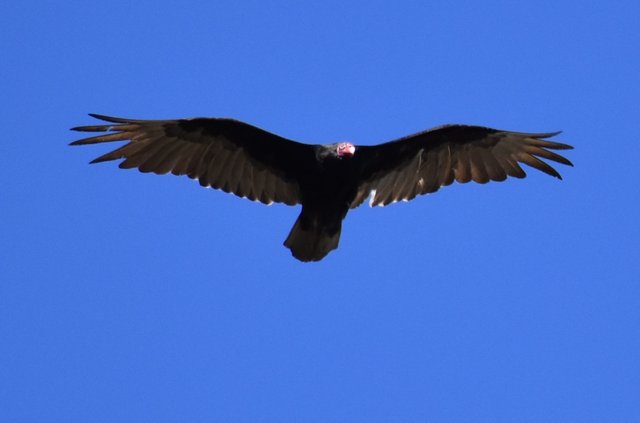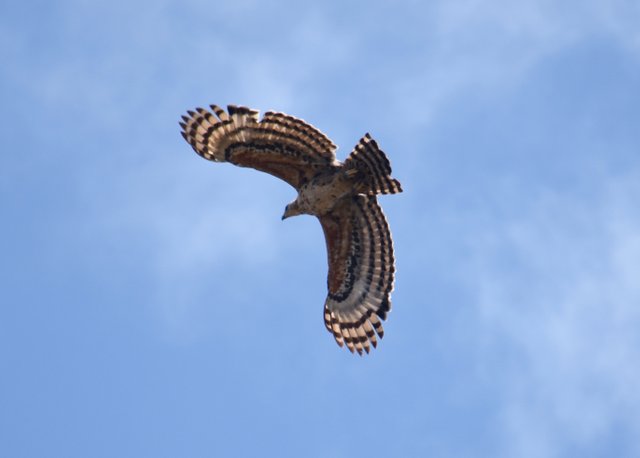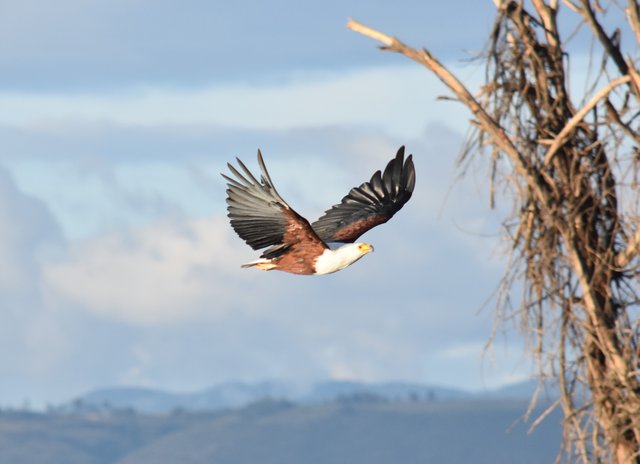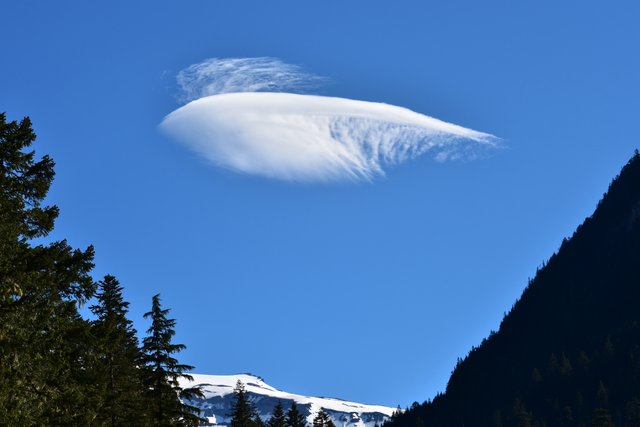Molt Strategy in Large Raptors

Notice that all of the wing flight feathers look new and perfect in this Turkey Vulture. It is probably a first year bird, who has yet to replace any of its first set of feathers.
All birds have feathers, and all feathers wear out and need to be replaced regularly. The process of replacing feathers is called molt. All birds have one (sometimes two) molts each year where they replace their feathers. This typically happens after the breeding season, when food is still in good supply, and after laying eggs and raising young. Production of offspring is critical to the birds in order to pass on their genetic material, and to sustain the species, but it takes second place to the importance of molt. In years when food supply is short a bird can opt out of breeding, and this happens regularly when expected rains do not happen, when weather patterns do not coincide with the critical time to breed for migrant species, or for many other reasons. If an individual bird, or a pair of birds, does not rear a clutch of young, they can always try again next year or later in the season. If a bird does not replace its feathers regularly it will become weakened in its ability to fly, to maintain body temperature, and to migrate if a migratory bird. If any of these things happen the bird will have a high chance of dying. Therefore molt is always attempted, even if it is at the expense of reproduction.

Note in this African Crowned Eagle, a very large eagle, that the outer 7 primary feathers are all fully grown, but that the inner 3 are different. Likely the innermost has been completely replaced (P1) and the next two are almost fully regrown (P 2and 3) on each side. Also some of the inner wing feathers, called "secondary" feathers, are being replaced.
The plumage a bird has after its annual complete body molt is called the basic plumage, and so the molt into basic plumage is called the pre-basic molt. During the prebasic molt most birds replace all of their feathers, both their body feathers and their wing and tail feathers. The wing and tail feathers are collectively called “flight feathers.” Very large birds, including large raptors, have such big flight feathers that it takes along time to grow an individual feather. Raptors are highly dependent on expert flight, and so cannot replace several flight feathers at the same time, and so there just is not enough time in the year to replace all of the flight feathers one after another. For this reason (experts think) large raptors, and some other large birds like albatrosses, geese, and others use a staggered molt strategy, often called “Staffelmauser molt” strategy.

In this African Fish Eagle notice that the outer primary feather on the right wing is long, the next one in is shorter as it has been shed and not fully regrown yet. Counting inward you'll see that the few feathers just inside the short 9th primary feather look brand new, showing very little wear. The outermost feather on the right side has wear on the inner veins, and will be replaced next after the 9th one grows out. This bird has likely also just replaced many of the innermost flight feathers as they look crisp and new, but the two innermost primary feathers look ragged, likely they are older and more worn.
In this strategy after one year of life when the raptor needs first to molt it’s wing flight feathers (remiges) the innermost primary wing feather will usually be shed and replaced first. When this is almost grown out the second from the inner end of the primary feathers is shed, and this continues until after maybe 4-5 primary feathers are replaced molt is suspended. The next year when molt begins again it starts in more than one place at a time. The innermost flight feather is again replaced at about the same time as the nest in line to be replaced going outward from the year prior, maybe the 5th or 6th primary feather. Then each year the molt resumes both at the innermost end, and at the next feather in line from the last one replaced in the prior year. This can lead to two, or in the largest of birds three remiges being replaced on each side.
This strategy allows large raptors to gradually and regularly replace their remiges while maintaining good flying ability at all times.

No raptor and no molt here, just mixing things up with a cool photo of a cloud I like.
It can also lead to scruffy looking large raptors who look like many feathers are missing or shorter than the others. The next time you see a raptor soaring who has several gaps in the wing feathers, remember that this is the normal process of primary flight feather replacement. You can also feel smart if you mention that you know this bird is not a juvenile (who always have all perfect new flight feathers because they were just born this year and have not lost any yet) and that she staggered, or Stoffelmauser molt is underway.
Good birding. Steem on! Check out @birdersofsteem a place where birders can support and see the work of other birders.
Some great photos! I wondered how large birds of prey (and others heavily dependent on flying/gliding) handle the molting process. We used to keep geese and ducks, and there just seemed to be feathers everywhere when it was molting "season." We could look at some of the birds and shake our heads and clearly see "You're not flying ANYwhere with those wings!" But those were domestic birds.
Appreciate the detailed explanation!
Birds like game birds, some water birds like ducks, loons, etc are able to go to safe places with lots of easy food and lose all of their feathers at once, eat like crazy and regrow them all at the same time. They are flightless at that time but can usually survive, so the strategy works for them. Most other birds molt sequentially, i.e. all their flight feathers in a sequential order until the molt is done. Very large birds with huge flight feathers use the strategy discussed above. I find molt interesting. Are you a birder? If so check out @birdersofsteem.
Beautiful birds and photos ;)
Thanks.
Excellent photos! birds of prey in flight look very graceful!
@ratel I reached out earlier. I'd like to feature you as the first of what I hope to be weekly "featured birder" on @birdersofsteem. It will be easy, I hope give you positive publicity, and be fun. If possible get back to me by email birdersofsteem - at- gmail - dot- com to brainstorm how to do this. Keep up the good work.
yesterday i sent you email.
World of Photography
>Visit the website<
You have earned 6.50 XP for sharing your photo!
Daily photos: 1/2
Daily comments: 0/5
Multiplier: 1.30
Block time: 2018-06-24T20:23:54
Total XP: 507.85/200.00
Total Photos: 82
Total comments: 0
Total contest wins: 0
Follow: @photocontests
Join the Discord channel: click!
Play and win SBD: @fairlotto
Daily Steem Statistics: @dailysteemreport
Learn how to program Steem-Python applications: @steempytutorials
Developed and sponsored by: @juliank
Nice Picture birdbanter ! :D
We would love to invite you to our Discord server.
In here we have more artists for you to connect to and
the ability to promote yourself and your blogs. Keep on Steemin my friend !
http://discord.gg/B6CxGGS
You got a 5.70% upvote from @upme thanks to @birdbanter! Send at least 3 SBD or 3 STEEM to get upvote for next round. Delegate STEEM POWER and start earning 100% daily payouts ( no commission ).
This post has received a 14.4 % upvote from @boomerang.
Congratulations @birdbanter! You have completed some achievement on Steemit and have been rewarded with new badge(s) :
Click on the badge to view your Board of Honor.
If you no longer want to receive notifications, reply to this comment with the word
STOPTo support your work, I also upvoted your post!
Do not miss the last post from @steemitboard!
Participate in the SteemitBoard World Cup Contest!
Collect World Cup badges and win free SBD
Support the Gold Sponsors of the contest: @good-karma and @lukestokes
Nice article and photos,
happy Birding from Munich,
Denis
This post has received votes totaling more than $50.00 from the following pay for vote services:
smartsteem upvote in the amount of $13.66 STU, $14.10 USD.
jerrybanfield upvote in the amount of $8.82 STU, $9.10 USD.
upme upvote in the amount of $7.98 STU, $8.24 USD.
rocky1 upvote in the amount of $7.13 STU, $7.36 USD.
therising upvote in the amount of $7.23 STU, $7.46 USD.
boomerang upvote in the amount of $6.46 STU, $6.66 USD.
For a total calculated value of $51 STU, $53 USD before curation, with a calculated curation of $13 USD.
@birdbanter, you may opt-out of transparencybot messages by simply replying to this comment and using the tag #TBopt-out. Click here to learn more.